What If? Writing Prompts: Nature IV
It’s Earth Day this week, so let’s mark the occasion with some new “What If?” Writing Prompts! To spark your “natural” creativity, here’s a new set of prompts set to the theme of nature and environmentalism! What sorts of stories can you create from these ideas? Have fun!
 What if… all wildlife rose up in a revolution against humankind?
What if… all wildlife rose up in a revolution against humankind?
What if… one tree were planted for every person in the world?
What if… a global effort were made to end all pollution?
What if… the entire world population could be fed on sustainable food sources?
What if… only you had the power to save the natural world from total destruction?
Good luck writing more tales about nature and the environment!
If you have any “What If?” writing prompt suggestions (for any theme), please feel free to share them in the comments below. Ideas I like may be featured in future “What If?” posts, with full credit and a link to your blog (if you have one)! Also, if you’ve written a piece based on an idea you’ve found here, be sure to link back to the respective “What If?” post. I would love to see what you’ve done with the prompt! Thank you!
What If? Writing Prompts: Humor III
While we’re on the topic of comedy, why not help yourself to some new “What If?” Writing Prompts to go with the theme? To inspire your whimsical side, here’s a new batch of prompts in the humor genre! See what silly stories you can write from these ideas! Enjoy!
 What if… you were walking outside when it suddenly started raining chocolate?
What if… you were walking outside when it suddenly started raining chocolate?
What if… you were trying to get a song out of your head, but people kept humming it everywhere you went?
What if… every answer you gave had to rhyme with the question?
What if… you knew someone was going to prank you… and you had to figure out a way to make it backfire on them?
What if… every day were April Fools’ Day?
Good luck writing some more humorous tales!
If you have any “What If?” writing prompt suggestions (for any theme), please feel free to share them in the comments below. Ideas I like may be featured in future “What If?” posts, with full credit and a link to your blog (if you have one)! Also, if you’ve written a piece based on an idea you’ve found here, be sure to link back to the respective “What If?” post. I would love to see what you’ve done with the prompt! Thank you!
My Top Five Humor Tropes
What’s life without whimsy? Laughter truly is the best medicine, which is why many writers like to include a little comedy even in dramatic works. Humor is one of the most appealing genres of fiction, but it’s also one of the most challenging to write. That’s where humor tropes come in! When in need of a little comedy, a good humor trope may be just the thing to lighten the mood and keep your stories from becoming too grim.
So in the spirit of April Fools’ month, here are five of my favorite humor tropes. I hope you’ll find these as entertaining as I do! Enjoy!
1) Lampshade Hanging
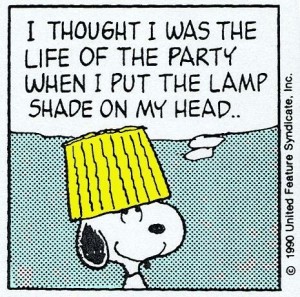 Lampshade Hanging is easily my favorite humor trope. I wrote a whole post about it in my first few months of blogging! I just love when fictional characters draw attention to the ridiculousness of a situation they’re in, almost as if they’re purposely leaning on the fourth wall to let the audience know they “see it too”. The practice of “hanging lampshades” is a handy technique writers use to demonstrate their own awareness of intentional details in their stories that would otherwise be dismissed by the audience as mistakes or simply bad writing – a sort of “self-deprecation” device, if you will. Note that the best way to use a lampshade in comedy is as a standalone comment: bring it up once, then move on and never mention it again. A classic way to entertain your audience while keeping the critics at bay, Lampshade Hanging is a great go-to trope for adding a touch of clever humor to your stories!
Lampshade Hanging is easily my favorite humor trope. I wrote a whole post about it in my first few months of blogging! I just love when fictional characters draw attention to the ridiculousness of a situation they’re in, almost as if they’re purposely leaning on the fourth wall to let the audience know they “see it too”. The practice of “hanging lampshades” is a handy technique writers use to demonstrate their own awareness of intentional details in their stories that would otherwise be dismissed by the audience as mistakes or simply bad writing – a sort of “self-deprecation” device, if you will. Note that the best way to use a lampshade in comedy is as a standalone comment: bring it up once, then move on and never mention it again. A classic way to entertain your audience while keeping the critics at bay, Lampshade Hanging is a great go-to trope for adding a touch of clever humor to your stories!
2) Brick Joke
It’s gonna be legen… wait for it… [falls asleep]
You know when a joke is set up at one point in a story only for the punchline to come later, when you’ve almost forgotten about it? Well, that’s a special kind of humor device called a Brick Joke. This is the comedic version of the Chekhov’s Gun, when the conclusion to a funny scene is delivered separately from its beginning after several unrelated events have happened in between. This trope is named after an old joke consisting of two parts, the first ending with an underwhelming punchline about a brick and the second ending with a twist that recalls the same brick. The humor of a Brick Joke comes from subverting the audience’s expectations: what at first appear to be separate situations turn out to be two parts of the same joke. To properly execute a Brick Joke, scatter a few jokes between the set-up and the punchline so as to either dissuade the audience’s suspicion that the first part was building up to a joke or trick them into thinking the first part was the joke. With the right timing, this trope can score major laughs from your readers! They won’t know what hit ’em!
[5 minutes later; waking up when the door slams] -dary!
– Barney Stinson, How I Met Your Mother (Season 2, Episode 11 – How Lily Stole Christmas)
3) Running Gag
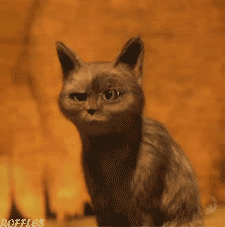
Ooooh! (Puss in Boots, 2011)
A sister trope of the Brick Joke, the Running Gag is another popular comedic device, especially in TV series. It’s also one of the riskiest; when done poorly, it quickly becomes annoying, but when done well, it can rake in a lot of laughs. A Running Gag is basically a joke that’s repeated over the course of a story or series (a minimum of three times), sort of like a recurring punchline to the same Brick Joke. It usually involves the same character(s) each time it comes up, though this needn’t be the case when the humor of the gag is entirely in the action itself. The key to a good Running Gag is timing: space the punchline recurrences far enough apart to keep the joke from wearing out too quickly, but add enough recurrences to draw as much laughter from the audience as possible. This may take a lot of practice to get right, especially since humor is so subjective, but once you get the hang of it, the Running Gag can make an excellent addition to your arsenal of comedy tropes!
4) I Resemble That Remark
Amy: You were being totally obstinate!
Knuckles: I don’t know what “obstinate” means, but I refuse to learn.
– Sonic Boom (Season 1, Episode 22 – The Curse of Buddy Buddy Temple)
Sometimes in comedy, one character will call another out on a flaw, only for this second character to object… in a way that demonstrates the exact flaw they’re denying. I Resemble That Remark is one example of the many humorous uses of irony, in this case comically subverting characters’ perceptions of themselves. It’s one of those comedic devices that draws its humor from an element of truth, as it plays on the all-too-common scenario where a trait that a person will swear is nothing like them will in fact turn out to be one of their defining characteristics. Think of it as an exercise in learning to laugh at yourself; if you find yourself identifying with fictional characters who can’t see their own shortcomings, maybe it’s time to reevaluate that idealized self-image!
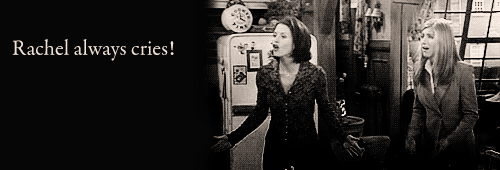
Monica: Rachel always cries!
Rachel: [sobbing] That’s not true!
– Friends (Season 4, Episode 4 – The One With The Ballroom Dancing)
(Source: Tumblr)
5) Hypocritical Humor
Mike: I’m gonna go to the bathroom.
Phoebe: Okay, well you put down the toilet seat.
Mike: Yes, dear. [leaves]
Monica: Is that a bit you guys do?
Phoebe: Uh-huh, we’re playing you two.
Monica: We don’t do that! [to Chandler] Tell her we don’t do that!
Chandler: Yes, dear.
– Friends (Season 9, Episode 16 – The One With The Boob Job)
The previous item on this list is a subtrope of a device known as Hypocritical Humor. This trope comes in a variety of flavors: saying one thing and doing the exact opposite, exhibiting a behavioral flaw immediately after denying said behavior, criticizing or making fun of others for faults of which the accuser him- or herself is guilty, or ignoring several warnings of an impending event only to get upset when said event happens. One particularly hilarious form of this trope is when the irony comes from the universe aligning itself exactly right to contradict a statement the exact moment after someone says it, which can either be a way of tempting fate or invoking karmic justice, depending on the nature of the statement. Note that Hypocritical Humor in fiction constitutes jokes that are intentionally added to a story to be played for laughs; unintentional hypocrisy is more likely attributable to bad writing and, in cases where it still evokes some laughter, may fall under a phenomenon known as Narm (that is, what is meant to be serious but is accidentally funny instead). Be careful how you deploy that hypocrisy in your fiction!
What are your favorite humor tropes? Which humor tropes have you used in your stories?
#WQWWC Writers Quote Wednesday Writing Challenge – Magic
It’s time for another round of Silver Threading and Ronovan Writes‘s Writers Quote Wednesday Writing Challenge! I had so much fun with the romance prompt a couple of weeks ago that I decided to participate again! Here goes nothing!
The theme posted last week is one of my favorite creative writing topics: magic! The quote I chose for this challenge is by one of my favorite authors from my childhood, Roald Dahl:
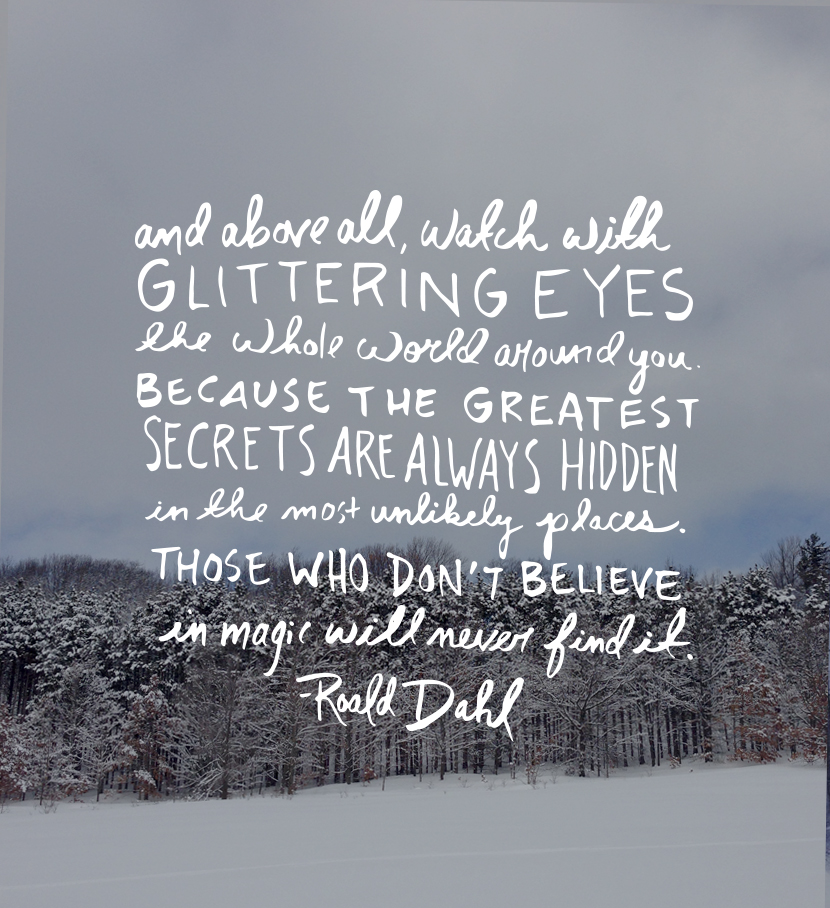
And above all, watch with glittering eyes the whole world around you because the greatest secrets are always hidden in the most unlikely places. Those who don’t believe in magic will never find it. – Roald Dahl
This quote comes from Dahl’s last children’s story, The Minpins. In fact, these are the very last lines of his last story, making this quote a final message to his young readers before he passed on. Beautifully said, Mr. Dahl! And now here’s a short story I wrote inspired by this lovely quote. Enjoy!
Believe
Abby watched from behind a tree, waiting quietly with a piece of string clutched tightly in her hand. She had laid candies and chocolates under the box a few feet ahead; surely something would be hungry enough to come along and eat them soon.
She was right; within ten minutes, a few little balls of light appeared from behind another tree across the clearing. Abby watched as they slowly floated over to the box, and the moment they landed on the sweets, she pulled the string. A stick attached to its other end dislodged from under one side of the box, dropping it and trapping the figures inside.
“Gotcha!”
The eight-year-old grabbed a large glass jar sitting beside her and ran over to the box. A minute later, the jar contained a handful of small chocolates and three colorful glowing fairies. Abby smiled at the tiny creatures inside, who were too busy nibbling away at the sweets to even notice they had been captured.
“Don’t worry,” she whispered as if they were listening to her. “I promise I’ll let you go tomorrow.”
And she hurried away through her backyard into her house to punch some holes in the lid. She could hardly wait for tomorrow.
The next morning, Abby took the jar to school for Show and Tell. She was so excited for her classmates to see what she had caught that she couldn’t stop fidgeting in her seat. When it was finally her turn, she pulled the jar out of her backpack and hurried to the front of the room to proudly display it to the class. To her surprise, however, they simply stared at her in confusion.
“What’s so special about a jar of chocolates?” said a boy in the front row.
“It’s not the chocolates,” said Abby, amazed that anyone would ask such a silly question. “It’s what’s eating the chocolates!”
The other children looked closer, but they merely giggled in amusement.
“There’s nothing eating the chocolates!” a girl in the back exclaimed.
“Yes, there is! Look! Don’t you see the fairies?”
“Fairies?!” At this, all the other children burst out laughing. “There’s no such thing as fairies!”
“Ya-huh, they’re right here!” Abby held the jar up for the whole class to see, but the tiny glowing figures only seemed to be visible to her. All the other students began pointing at her and jeering.
“Abby believes in fairies!” they shouted. “What a dummy!”
The teacher tried to calm the class while Abby hugged the jar close, bowing her head to hide her watering eyes. She spent the rest of the school day sitting quietly in the corner of the room, and she went home that afternoon in tears.
That evening, Abby sat crying on her back porch, the fairies eating a fresh helping of candies in the jar beside her. She was so lost in thought over the day’s events that she didn’t realize a man had stepped out the back door onto the porch until he spoke.
“Abby, sweetheart, what’s wrong?”
Startled, Abby looked up to see her father standing to her right. Suddenly embarrassed, the girl wiped the tears from her eyes before she answered.
“Nothing, Daddy.”
“Are you sure?” His daughter looked away as he sat down beside her. It was then that he caught sight of the jar sitting between them. “Could it have anything to do with these fairies?”
Abby snapped her head up, her eyes wide with shock. Her father smiled.
“Your friends can’t see them either, huh?”
The girl hesitated, then shook her head. The next thing she knew, she was sharing all the events of the past 24 hours, from catching the fairies to trying to show them to her class to crying on the way home after being teased. She then listened as her father told his childhood story about the time he had found a gnome in his mother’s garden and tried to show it to the neighbor kids, only to be made fun of for having an “imaginary friend”.
“They laughed at me for weeks”, he said with a shrug, “but I knew what I saw. That gnome was no more imaginary than these fairies.”
He lifted the jar and unscrewed the lid. Abby reached out her hand and her dad tilted the jar to let one of the glowing creatures tumble out into her palm. It was still nibbling on part of a chocolate coin. Father and daughter laughed as the former reached into the container and extracted a lollipop from which the other two fairies were dangling.
“Daddy”, said the eight-year-old as she stared curiously at the creature in her hand, “why can’t the other kids see them?”
Abby’s father set the fairies down on the porch, then split the lollipop in half and offered a piece to each of them. He thought seriously for a moment before turning back to his daughter and smiling again.
“Because they aren’t looking for them.”
Abby faced her dad once more as he scooped the fairies up from the porch. She was too amazed to speak, instead sitting in stunned silence while they both watched the tiny creatures munching away on the sweets in their hands.
“Don’t ever change, princess,” he said after a minute. “This is my greatest advice to you. Keep on believing in magic. Always look for the beauty in the world. And above all, watch with glittering eyes the whole world around you, because the greatest secrets are always hidden in the most unlikely places.”
Father and daughter grinned at each other, then simultaneously lifted their hands to let the fairies fly away into the forest behind their house. Abby huddled close to her father when he put his arm around her, and as the two of them watched the little balls of light disappear into the night, he whispered with a smile…
“Those who don’t believe in magic will never find it.”
I hope you enjoyed my story! Be sure to join the Writers Quote Wednesday Writing Challenge and share your quote-inspired works! Thanks for reading!
Writers Quote Wednesday Writing Challenge is a weekly blogging event by Colleen Chesebro of Silver Threading in collaboration with Ronovan Hester of Ronovan Writes. Be sure to check out both these authors’ blogs for your weekly dose of inspiration! Happy writing!
7 Ways I Find Writers’ Blogs
Writers are everywhere, and with the advantages of the Internet and blogging, it’s never been easier for us all to connect with one another. Blogging is a great way for writers to put themselves out there and gain some kind of footing for their work, but it can seem rather daunting to find ways of reaching potential readers in the vast ocean that is the blogosphere. In fact, this is an art I’m still trying to master myself, and for that I can’t say much on this subject from the perspective of a writer. I can, however, speak as a reader and share how I found over 200 writers’ blogs to follow.
So for those of you constantly seeking inspiration and new friends in the blogosphere, here are the top seven ways that I find writers online. I hope you’ll find these useful too! Enjoy!
1) “Creative Writing” tag in WordPress Reader
 WordPress is the ultimate blogging platform, no contest. With high design flexibility and an integrated blogging network, it’s an excellent choice for writers to start building an online presence, whether it’s free on WordPress.com or self-hosted with WordPress.org. Because my site is connected to WordPress.com through Jetpack, I found it easiest to start searching for other writers through the WordPress Reader. There are several tags through which to find writers’ posts, of course, but already a general search for “creative writing” tends to return plenty of interesting results. There’s always something new to find in the Reader, so checking back regularly definitely helps to expand a followed blogs list!
WordPress is the ultimate blogging platform, no contest. With high design flexibility and an integrated blogging network, it’s an excellent choice for writers to start building an online presence, whether it’s free on WordPress.com or self-hosted with WordPress.org. Because my site is connected to WordPress.com through Jetpack, I found it easiest to start searching for other writers through the WordPress Reader. There are several tags through which to find writers’ posts, of course, but already a general search for “creative writing” tends to return plenty of interesting results. There’s always something new to find in the Reader, so checking back regularly definitely helps to expand a followed blogs list!
2) Twitter
 After setting up a blog, the next step for a writer is to create social media profiles. An online network is indispensable for an artist hoping to get their work noticed, and of all the networks I use regularly, Twitter has proven to be a goldmine of writers’ profiles. Author posts and retweets, book promotions, contest invitations, anything writing-related can be found on Twitter, and many of the connections I’ve made on WordPress actually started there. Using hashtags and regularly retweeting other writers have proven to greatly increase one’s following; I’ve found many writers on this network thanks to their mastery of these practices, so if you’re new to Twitter, you’d be wise to try taking them up too!
After setting up a blog, the next step for a writer is to create social media profiles. An online network is indispensable for an artist hoping to get their work noticed, and of all the networks I use regularly, Twitter has proven to be a goldmine of writers’ profiles. Author posts and retweets, book promotions, contest invitations, anything writing-related can be found on Twitter, and many of the connections I’ve made on WordPress actually started there. Using hashtags and regularly retweeting other writers have proven to greatly increase one’s following; I’ve found many writers on this network thanks to their mastery of these practices, so if you’re new to Twitter, you’d be wise to try taking them up too!
3) Writing communities
While I’m not nearly as active in writing communities as I should be, I added this item to my list because some of the few writers I have met through communities are among the writers I’ve connected with the most. The contests and events on Writer’s Carnival (which I found through Twitter) have been a great way to meet and befriend other writers, especially since the community strongly encourages its members to review each other’s work. Among so many other artists sharing the same interests, goals, and fears as you, a writing community is a great place to find new friends!
4) Blogrolls
Want to make sure your blog is connected to the rest of the blogosphere? Use links! WordPress.com blogs come with blogroll widgets that display Gravatars of followers and followed blogs, and I’ve found many new blogs through these links. Self-hosted WordPress bloggers can find alternative widgets in the plugin directory for sharing blogs they like, and other blogging platforms also offer easy ways to showcase links to favorite sites in the sidebar. Blogrolls are handy tools for writers: not only does sharing links throughout your site drastically increase your connection to the blogosphere, but it encourages other bloggers to return the favor, earning you plenty of exposure for a simple kind gesture!
5) Blogging events/writer link-ups
If you’ve been reading my blog for a long time, you may remember that I used to participate in a monthly blogging event called Writers Reveal. This was a blog-swap event where we would send each other topics by email and all share our posts around the same time. It was a good way to connect with and promote other writers, since we always shared links to each other’s blogs at the end of our posts. I’ve met quite a few interesting writers through this event, and even more just by following links in posts for other blogging circles. Participating in blogging events is a great way to make new friends, plus it’s loads of fun!
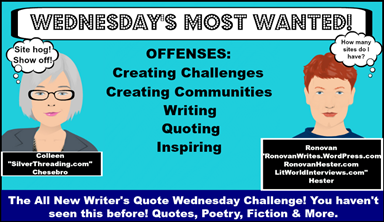
The most recent blogging event I’ve joined: Writers Quote Wednesday Writing Challenge, by Silver Threading and Ronovan Writes
6) Guest posts
Speaking of connecting with other writers, guest posts are another useful method of forming links between blogs. I’ve found plenty of new writer blogs to follow through links in guest posts, blogs that I might not have found any other way. Similar to blogging events, guest post exchanges strengthen connections between bloggers via links to one another’s sites, helping each writer expand their reach to the other’s audience and introducing all readers to new and interesting content. Win-win-win!
7) Chris the Story Reading Ape (i.e. Reblogs)
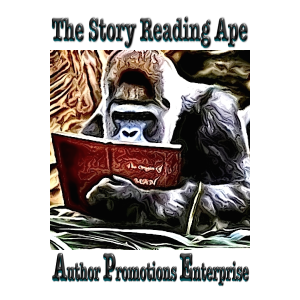 I single out Chris the Story Reading Ape here because he’s pretty much the king of this practice in the creative writing domain, but there are several writers I follow on WordPress who make a habit of reblogging each other’s posts. Chris‘s blog is a goldmine of writing articles and resources, all in the form of reblogs from other writers’ sites. WordPress reblogs always include a link to the original post, so I’ve come across tons of new blogs to follow just by browsing through his archive. WordPress writers, take note: reblogs are a valuable tool for sharing your favorite content and helping writers you like expand their network. The blogosphere grows on a you-scratch-my-back-I-scratch-yours principle; reblogging each other’s posts helps all us writers better connect with one another and expand our voices in the world!
I single out Chris the Story Reading Ape here because he’s pretty much the king of this practice in the creative writing domain, but there are several writers I follow on WordPress who make a habit of reblogging each other’s posts. Chris‘s blog is a goldmine of writing articles and resources, all in the form of reblogs from other writers’ sites. WordPress reblogs always include a link to the original post, so I’ve come across tons of new blogs to follow just by browsing through his archive. WordPress writers, take note: reblogs are a valuable tool for sharing your favorite content and helping writers you like expand their network. The blogosphere grows on a you-scratch-my-back-I-scratch-yours principle; reblogging each other’s posts helps all us writers better connect with one another and expand our voices in the world!
How do you find other writers online? What are the best ways you’ve found to attract followers to your blog?
Writers Quote Wednesday Writing Challenge – Romance
Silver Threading and Ronovan Writes‘s Writers Quote Wednesday is changing things up! Instead of simply sharing an inspirational quote, the challenge now is to write a flash fiction story or poem to go with it! Sounds like fun!
This week’s theme was romance, and the quote I chose is one commonly attributed to Dr. Seuss:
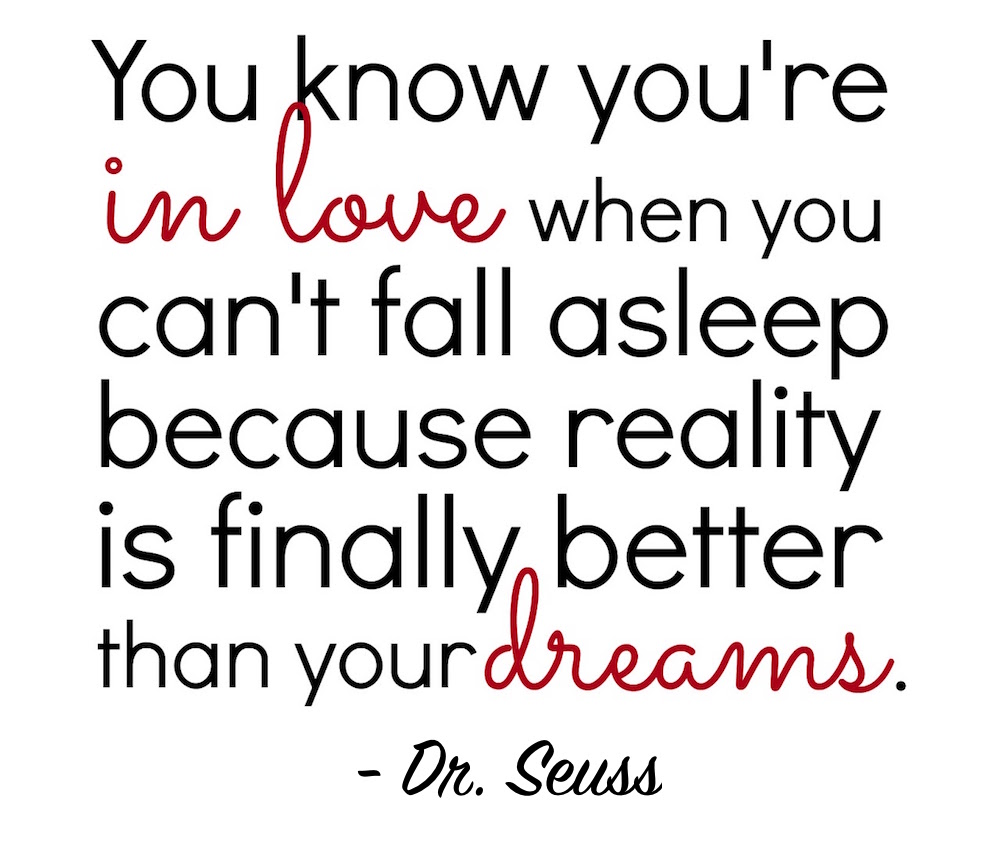
You know you’re in love when you can’t fall asleep because reality is finally better than your dreams. – Dr. Seuss
I know so many quotes have been misattributed to Dr. Seuss that it’s hard to tell the true from the false, but though I have yet to find a credible source saying this quote is in fact a Seuss/Geisel original, I thought it was too beautiful to resist sharing for this theme. So without further ado, here’s a short romantic poem I wrote based on this lovely quote. Enjoy!
Insomnia
Awake in bed
Each night I rest,
The feelings inside me
Put to the test.
I gaze outside
At the starry skies,
Dreaming of you
Without closing my eyes.
Against the lure
Of sleep I fight.
I won’t let this feeling
Be lost to the night.
But though the dreams
May call from above,
They never can vanquish
The power of love.
Try as they might,
They’ll never tempt me.
They can’t be as good
As my reality.
Awake through the night,
I smile as I think,
‘Til I rest in your arms,
I won’t sleep a wink.
I hope you enjoyed my poem! Be sure to join the Writers Quote Wednesday Writing Challenge and share your quote-inspired works! Thanks for reading!
Writers Quote Wednesday Writing Challenge is a weekly blogging event by Colleen Chesebro of Silver Threading in collaboration with Ronovan Hester of Ronovan Writes. Be sure to check out both these authors’ blogs for your weekly dose of inspiration! Happy writing!
Off The Bookshelf: A Fish Caught in Time – The Search for the Coelacanth
How about a new book recommendation for this year’s reading list? This one’s a little different from my other Off The Bookshelf entries as it’s actually a nonfiction tale, and a marine biology-themed one at that! I read this book last year for school, and I was so enraptured by this incredible true “scientific epic” that I had to share it on my blog.
So if you’ve never heard of the coelacanth, or you have but want to learn the details of its history, you’re in for a treat! I hope you’ll enjoy my review of this must-read book: A Fish Caught in Time: The Search for the Coelacanth by Samantha Weinberg.
Summary
A Fish Caught in Time tells the true story of the coelacanth (SEE-luh-kanth), one of the most mysterious and fascinating fishes (yes, “fishes“) in scientific history, as written by English journalist Samantha Weinberg. Originally published in 1999 by HarperCollins, the book recounts the events surrounding this prehistoric fish, from the shocking discovery of a living specimen (Latimeria chalumnae) in 1938 to the discovery and study of a second species (Latimeria menadoensis) 60 years later. The narrative relates these events from the perspective of the researchers who dedicated much of their time and resources to studying this fish, all of whom played an important role in the amazing story of the elusive “King of the Sea”.
Review
I read this book last year in preparation for a Vertebrate Zoology class I had to help teach as part of my Master’s program. My lesson was about the Sarcopterygii class of fishes, so my professor lent me his copy of A Fish Caught in Time as supplementary material for telling the story of the coelacanth. By the time I was done, I was ready to teach an entire semester on this one fish. I never thought I would feel so strongly about any one fish, but then again, the coelacanth is no ordinary fish.
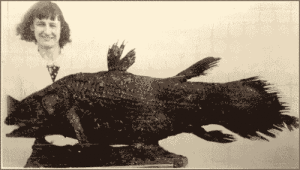
Marjorie Courtenay-Latimer with the modern coelacanth (Latimeria chalumnae) she discovered in 1938
To summarize, the coelacanth was long thought lost to history by the Cretaceous-Paleogene extinction event that wiped out three quarters of the plant and animal species living on Earth (most famously the dinosaurs). It was known only by its fossil record for (almost exactly) 100 years, until, to the world’s surprise and excitement, a living specimen was fished off the South African coast in 1938. Over the next six decades, the coelacanth would be the focus of global headlines, political plays, and scientific rivalries, all the while remaining an enigma to the world that it continues to captivate to this day.
A rare example of a nonfiction story told in a highly narrative form, A Fish Caught in Time does an excellent job of capturing the majesty and mystery of the coelacanth while staying true to the history of its discovery and study. Ms. Weinberg paints such a vivid picture of this 60-year-long story that I couldn’t help but be completely drawn in, as if I were living the story along with the real-life characters: the excitement of discovering the coelacanth wasn’t extinct after all, the rush to find out where it had been hiding for the past 65 million years, the desperation to not only capture a living specimen but keep it alive at the surface, the awe that only a lucky few in history have ever known of watching this deep-sea fish swim in its natural habitat. I’d even go as far as to say that it’s impossible to read this book and not fall in love with the coelacanth!
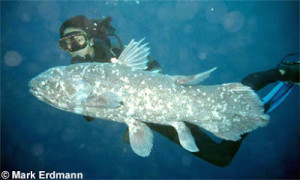
Arnaz Erdmann swimming with the Indonesian coelacanth (Latimeria menadoensis)
A fair note of warning: oftentimes the story focuses more on the researchers who dedicated their lives to studying the coelacanth than on the coelacanth itself. Readers who hope to gain an insight exclusively into the life of the fish may find this a bit off-putting, but then again, it hardly makes sense to attempt to recount the history around the animal without offering even a glimpse into the lives of the people who shaped that history. It’s much more than a story about a fish; it’s a lesson about what it means to be a researcher. It takes intelligence, curiosity, patience, an unquenchable thirst for knowledge, and an unrelenting passion for science, all of which shine through the pages of this brilliant narration of scientific truth.
Overall, A Fish Caught in Time is a captivating read that any science enthusiast will enjoy. I owe much of my appreciation for the coelacanth to this book, and I recommend it to anyone who wants to immerse themselves in a world of marine biology without being overwhelmed by the technicalities of it all. As quickly becomes evident from the first chapter, science doesn’t have to be fictional to blend well with creative writing!
Inspiration
I love science and I love a good story, but it’s rare that I get to enjoy both at the same time, or at least in the same book. A Fish Caught in Time offers an opportunity to glimpse the joy and passion that goes into conducting good science by presenting it in an enjoyable narrative format. Though much research has gone into understanding the coelacanth, A Fish Caught in Time never conveys that research in a manner too difficult for the layman to comprehend or appreciate, making it an unusual kind of literary gem: a scientific subject made accessible to the general public, that is, a community of non-scientific readers.
So if you appreciate science and a good story based on true events, A Fish Caught in Time may be just the inspiration you need for your creative writing! It certainly has been for me; in my opinion, there’s never too much writing inspiration to be found in science!
#WritersQuoteWednesday and #BeWoW – Albert Einstein
So I just discovered Silver Threading‘s Writer’s Quote Wednesday blogging event, a collaboration with Ronovan Writes‘ Be Writing on Wednesday event, and I thought to myself, “Hey, that sounds like fun! Maybe I should give it a try!” I do love quotes, after all, and writers can never have or share too much creative inspiration!
The quote I chose to share for this event is one of my all-time favorites: Albert Einstein’s wise words on the importance of imagination compared to knowledge.
I am enough of an artist to draw freely upon my imagination. Imagination is more important than knowledge. Knowledge is limited. Imagination encircles the world. – Albert Einstein
I first read the short version of this quote on a poster hanging in my seventh grade Science teacher’s classroom, and I remember that it instantly inspired me, especially since I had already decided by then that I wanted to be both a writer and a scientist. I always liked to believe that I could draw from both these sides of myself to succeed in life, that the imaginative artist in me would empower the knowledgeable scientist and vice-versa. This quote validates my belief that the power of the human mind is more than just what a person knows, and having come from one of the most brilliant minds in the world makes it all the more motivating. To this day, Einstein’s words remind me of the true meaning of education and intelligence: it’s not the number of facts you can memorize that matters, but the capacity you have to think and explore beyond the limits of this restricted world. Fellow writers, take heart: if you’re brave enough to set your imagination free, you can accomplish anything!
What’s your favorite inspirational quote? Be sure to check out #WritersQuoteWednesday and #BeWoW to share it with the rest of us!
#WritersQuoteWednesday is a weekly blogging event by Colleen Chesebro of Silver Threading. #BeWoW is a weekly blogging event by Ronovan Hester of Ronovan Writes. Be sure to check out both these authors’ blogs for your weekly dose of inspiration! Happy writing!
What If? Writing Prompts: Love and Peace II
It’s the month of love, so why not celebrate creatively with some more “What If?” Writing Prompts? It’s been a long time since I’ve shared a set of love and peace prompts, so here are a few new ones for you to try! See what stories you can create from these ideas! Enjoy!
 What if… the world’s only religion/faith were Love?
What if… the world’s only religion/faith were Love?
What if… social tolerance were a subject taught in schools worldwide?
What if… the differences among people were only ever cause for celebration, not conflict?
What if… every nation made children’s education a top priority?
What if… for a brief time, there were no wars happening anywhere in the entire world?
Have fun writing more stories about love and peace!
If you have any “What If?” writing prompt suggestions (for any theme), please feel free to share them in the comments below. Ideas I like may be featured in future “What If?” posts, with full credit and a link to your blog (if you have one)! Also, if you’ve written a piece based on an idea you’ve found here, be sure to link back to the respective “What If?” post. I would love to see what you’ve done with the prompt! Thank you!
Romance Could Be Saved by Good Grammar: an Infographic by Grammarly
Valentine’s Day has come and gone, but love goes on and on! If you celebrated this year, I hope you had a wonderful Valentine’s Day (or Singles Awareness Day; I’m not judging). If, however, you found yourself lonely and longing for a significant other with whom to share the day, then fear not! You may be surprised to learn that there’s one commonly underrated trait that can help you attract a partner: proper grammar!
Grammarly partnered with eHarmony to determine whether the writing skills displayed in people’s online dating profiles affect their chances of finding romance, and, in true Grammarly fashion, they summarized the results along with other online dating statistics in an infographic. So if you’re searching for love, be sure to consider these helpful grammar tips; they may save your chances at romance! Good luck!
Today’s creative writing post is brought to you by Grammarly, the World’s Best Grammar Checker. For more information on Grammarly, visit https://www.grammarly.com/grammar-check. Thanks for reading! Happy writing!


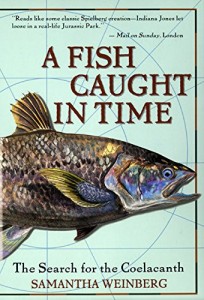
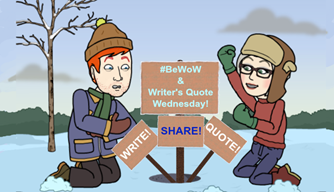
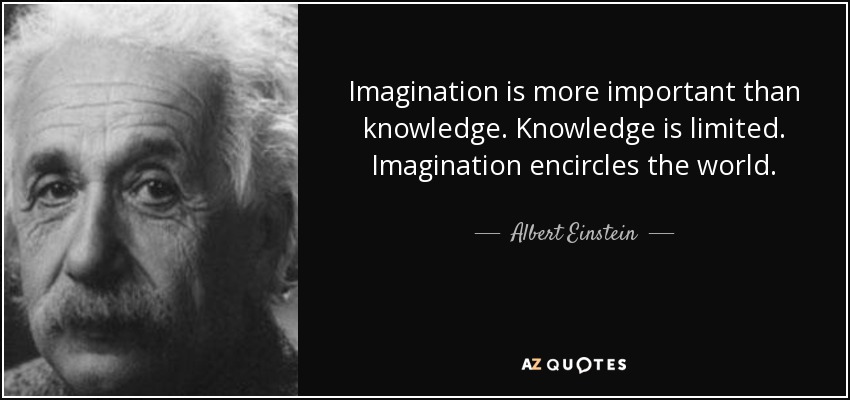


Recent Comments